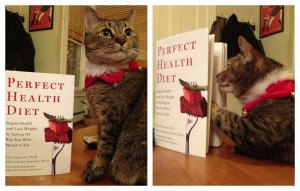Angelo Coppola has some nice things to say about our book:
Recently, I was asked by someone who had just completed reading two of the most popular Paleo diet books, which books I would recommend for further reading.
My response was something like, “Maybe you’ve read enough, and it’s time to ask yourself, ‘what’s next?’ What do you want to do with the Paleo approach, besides read about it?”
Well, my answer would have been different had he asked me this question after I had gotten my hands on the latest edition of The Perfect Health Diet…. I strongly recommend a short detour through Paul & Shou Ching Jaminet’s latest research.
Angelo also asked me to do a Q&A with his readers. He’s posted it and I have to say they asked some good questions. Several of them were questions our readers had previously asked us to comment on:
- Tatertot had asked our opinion on the “Potato Diet.” There has been a busy thread on the Mark’s Daily Apple Forum about “potato fasts” – eating potatoes only for a week or two – as a weight loss method. Angelo was curious what I thought.
- Against my claim that starch is better than sugar, the Ray Peat Forum solicited rebuttals, and Andrew Kim stepped forward with a series titled “Fructose is > Glucose.” Martin had asked for a response; Angelo and Michael A. Smith finally got me to write one up.
On the fructose issue, Marisa H asked a good question: “I am fructose intolerant. If fructose is sooooo great, why does this condition exist, and not glucose intolerance?”
Here are the questions Angelo’s readers posed:
- Do you have any specific tweaks or recommendations for those with autoimmune conditions? And with respect to infections, is the most common concern gut infection, or are there other types that people should be aware of to consider or look for in their attempts at healing? – Erin L.
- How important is it to have carbs with every meal vs. ‘backloading’ them all after a workout. – Phil U. (@philsplace)
- You talked about the correlation between the increase in omega-6 fats and overweight. Please explain why omega-6 fats contribute to weight gain. – Jack
- I’d love to hear Paul’s thought on Andrew Kim’s 4 part series of blog posts on “Fructose > Glucose”. – Michael
- What are your thoughts on the Potato Diet, which has been gaining some popularity in online Paleo communities as a short-term solution for weight loss? – Angelo
Head on over to Latest in Paleo to see my answers!













Recent Comments